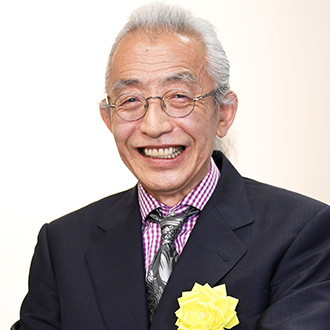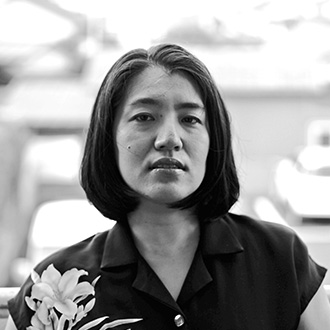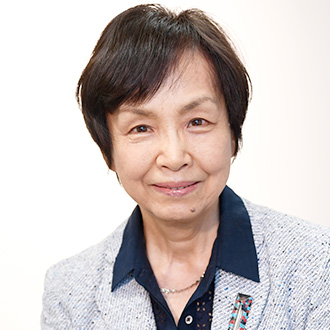
- Home
- Jury Information
The Jury of the Mitsubishi Asian Children's Enikki Festa
-
 Head of the Jury
Head of the Jury
Ichiro Sato -
 Assistant Head of the Jury
Assistant Head of the Jury
Meo Saito -
 Juror
Juror
Yoshino Ohishi -
 Juror
Juror
Akira Ikegami -
 Juror
Juror
Machiko Satonaka
Head of the Jury

Ichiro Sato (Oil Painter)
Profile
Born in Miyagi, in 1946. A Oil painter, Professor emeritus of Tokyo University of the Arts and President of the Tohoku Seikatsu Bunka University.
Graduated from the Department of Fine Arts at the Tokyo University of the Arts in 1970 and completed his masters in Oil Painting in the Department of Painting of the Graduate School of Tokyo University of the Arts in 1972. After completing a term as a research student at the same university in 1973, Mr. Sato enrolled as an exchange student (DAAD) at Hamburg Art University in Germany. He became an Assistant Professor in the Faculty of Fine Arts at Tokyo University of the Arts in 1981 after returning to Japan, and in 1986 he became an Associate Professor at the same university. In 1995, he served as a Monbusho-sponsored Japanese Overseas Research Fellow at Vienna Art University in the Restoration subject. From 1999 to 2014, he was professor in the Faculty of Fine Arts at Tokyo University of the Arts. From 2014 to 2019, he was a full-time professor at the graduate school of the Kanazawa College of Art, and he is currently serving as the President of the Tohoku Seikatsu Bunka University. His works include “Toshi Shozo no Zu” (Portrait in Perspective), “Choshokuban to Dennetsuki” (Palette and Heater), “Aoba” (Green Leaves), “Nachi no Otaki” (Great Fall of Nachi), and “Zao Okama” (Lake Okama in Zao).
Let us take joy in the 16th Mitsubishi Asian Children's Enikki Festa. Let us take heart in how the young artists are absorbing the transformation that digital technology is working on portraiture and illustration. They are absorbing that transformation in their pictorial expression and thereby coping in their own ways with the profound change underway in global society. The young artists display at the same time a heartwarming fidelity to their communities and households. That takes form strikingly in expressions of reverence for local deities, respect for the natural settings of their neighborhoods, and affection for their family members and friends.
For more than a decade have I had the honor of judging works in the Mitsubishi Asian Children's Enikki Festa, and the content and execution of the works have become more impressive with each Festa. At the same time, I have been equally happy to note an increase in the number of original and richly personal works.
Assistant Head of the Jury

Meo Saito (Painter)
Profile
Born in Tokyo in 1973. A painter, professor at Tokyo University of the Arts.
Graduated from the Department of Painting, Faculty of Fine Arts at the Tokyo University of the Arts in 1996, majoring in oil painting, and completed her masters at the university's Graduate School in 2001. Ms. Saito is currently professor of oil painting at the Department of Painting, Faculty of Fine Arts, Tokyo University of the Arts.
Ms. Saito composes finely detailed paintings of scenes witnessed in the course of her travels, in images that mix fact and fiction. They are notable for entering the realm of literary works with poetic phrases arranged alongside the paintings. Ms. Saito's major exhibitions include “Katamuku Koya - Bijutsukatachi no Shogen since 9.11 (Slanting House / Statements by the Artists in Japan since 9.11)” at the Museum of Contemporary Art, Tokyo, in 2002; “Aatisuto Fairu 2009: Gendai no Sakkatachi (Artist File 2009: The NACT Annual Show of Contemporary Art)” at the National Art Center, Tokyo, in 2009; and “Heisei 28 Aki no Yurin-so Tokubetsu Kokai - Mitsuai Mura (Villa Yurinso Special Open Fall 2016 - Immorale Ville).” Ms. Saito received the Ohara Museum Prize and Excellence Award at VOCA 2010. Her major literary works include “Adabana Zukan (Picture book of blossoms that bear no fruit)” (Geijutsu Shinbunsha) and “Yojohan Mikuji (The four-and-a-half tatami mat paper fortune)” (Geijutsu Shinbunsha).
This Mitsubishi Asian Children's Enikki Festa was the first that we judged after the COVID-19 pandemic had largely subsided. I was relieved to note how the children's works revealed for the most part that life had returned to normal. Numerous works also revealed the stunning magnitude of change that had occurred in different nations. I was astounded, meanwhile, at the urbanization depicted in works by children in what I had regarded as pastoral nations. Accompanying those depictions was a visible shift from a former preoccupation with family and community life to personal interests, whether hobbies or subjects of study. I especially enjoyed the works in which children deployed brilliant colors in engaging depictions of the overlap of traditional culture and urban progress.
Juror

Yoshino Ohishi (Photo Journalist)
Profile
Originally from Tokyo. A Photo Journalist.
After finishing Department of Photography, College of Art, Nihon University, Ms. Ohishi has been photographing and writing about people who courageously move on with their life despite devastating and unreasonable experiences inflicted by wars and riots. She was awarded prizes by Japan Congress of Journalists, Nihon Chimei Kenkyujo, and the Agency for Cultural Affairs of Japan for “Kanbojia kugai tensho (Cambodia: Reincarnation through hardship)” in 1994, followed by the Domon Ken Award (2001) for “Betonamu rin to (Living proudly in Vietnam)” as well as the Avon Award (2007) and the Medal with Purple Ribbon (2007) for her long-running contributions. Ms. Oishi was awarded the 2013 JCJ Award (Japan Congress of Journalists) for “FUKUSHIMA Tsuchi to ikiru (Living with soil in Fukushima).” In 2023, she received the Towa Futurist Award for her initiatives towards world peace.
Ms. Ohishi has published many photography books, including “Papua-jin (Papuan in highland New Guinea),” “Wani no tami: Meraneshia geijutsu no hitobito (Crocodile people supporting Melanesian art),” “Okinawa ni ikiru (Living in Okinawa),” “Yoru to kiri wa ima (“How are they now?” visiting the people survived from the concentration camps),” “Hiroshima hanseki no shozo (Hiroshima: History of a half century),” “Okinawa wakanatsu no kioku (Okinawa: Remembrance of early summer),” “Inochi no ki (Trees of life),” “Kosobo hakai no hate ni (Kosovo: The destruction),” “Afuganisutan senka o ikinuku (Surviving from devastation in Afghanistan),” “Kosobo zetsubo no fuchi kara asu e (Kosovo: From desperation toward hope),” “Kodomo ikusayo no naka de (Children living through wars),” “Fuhatsudan to ikiru: Inori o oru Raosu (Laos: Living with unexploded bombs),” “Kurokawa-no no sato: Shonai ni idakarete (Kurokawa Noh: Embraced by Shonai),” “Soredemo emi o (Smiling even in predicament),” and “Senso wa Owattemo Owaranai (War is not over even when it ends)”, and as of March 2019 “Senka no Kioku (Ravages of War)” and “Nagasaki no kizuato(The Scars of Nagasaki)” have also been published. Her latest publication is the 2022 book “Watashi no Kokoro no Lens Genba no Kioku wo Tsumugu (The Lens of My Heart: Weaving the Memories from the Frontlines).”
I am grateful to the young artists of the 16th Mitsubishi Asian Children's Enikki Festa for sharing their multifaceted perspectives on life in Asia. Adjudicating the works was challenging, but it was also invigorating. It was invigorating because the works were fairly bursting with energy and with the children's insightful perspectives on their lives and on society, on the love they receive from their families and on the love they return.
That energy and those perspectives presented a remarkable commonality among the diverse nations and the multifarious events depicted. On the other hand, I was intrigued at the contrast between expressive trends. Numerous artists from some nations depicted geographical immensity with bold strokes, whereas numerous artists from other nations opted for softer tones in their works. That diversity provided occasion for repeated contemplation in adjudicating the works of the latest Festa.
Juror

Akira Ikegami (Journalist)
Profile
Born in Nagano Prefecture in 1950. A journalist and also serves as Professor for Meijo University.
After joining NHK (Japan Broadcasting Corporation) in 1973, Mr. Ikegami worked as a reporter and a newscaster. In NHK's “Shukan kodomo nyu-su (News for kids weekly),” where he appeared in the role of father from 1994 to March 2005, After leaving NHK in March 2005, he is currently working as a freelance journalist.
Mr. Ikegami serves concurrently in roles that include special professor at Institute of Science Tokyo, visiting lecturer at Rikkyo University, and special professor at Shinshu University. He is a prolific author whose works include “Tsutaeru Chikara” (Communication capability),” “Ikegami Akira no Yasashii Keizaigaku (Akira Ikegami's easy economics),” “Shiranai to Haji wo Kaku Sekai no Daimondai (Major world problems that are embarrassing not to know about)” and the “Soudattanoka (Now I got to know…) series.”
Something that has struck me in adjudicating submissions to the Mitsubishi Asian Children's Enikki Festa over the years is a growing brightness. The COVID-19 pandemic prevented us jurors from gathering under the same roof for the previous Festa, and masks appeared on numerous figures depicted in the works. This time, the subsidence of COVID-19 was a liberating event that occasioned a visibly broader range of activity, and the pictorial content became notably brighter.
We encounter in the works a multiplicity of ethnicities, customs, and religions. The encounters are a reminder of Asia's incredible diversity. That very multiplicity offers immense promise for the emergence of new Asian possibilities. The illustrated diaries, meanwhile, furnish an invaluable opportunity for all to reflect on where their nations are coming from and where they are headed.
Juror

Machiko Satonaka (Manga artist)
Profile
Born in Osaka Prefecture, in 1948. A Manga Artist, and Director of the Japan Cartoonists Association.
As a high school student, Ms. Satonaka was awarded the first Kodansha New Cartoonist Award for “Pia no Shouzou” (Pia's portrait). She went on to publish works appealing to child and adult audiences, and dealing with a wide range of topics, and this year marks her 60th year as an artist.
Awards include the Lifetime Works and Cultural Activities award from the Japan Ministry of Culture and Science in 2006, the commendation of the Commissioner for Cultural Affairs in 2010, the Kojiki Grand Prize Ono Yasumaro Award for Manga Classical Literature - Kojiki (An Account of Ancient Matters) in 2013, the Foreign Minister's Commendation for FY2014, the 2018 Agency of Cultural Affairs 50th Anniversary Award, and the Person of Cultural Merit Award in 2023.
Ms. Satonaka has created a number of successful works including “Ariesu no Otometachi” (Maidens of Aries), “Umi no Oorora” (Aurora at the ocean), “Asunarozaka” (Asunaro Hill), “Aijintachi” (Lovers), “Jotei no Shuki” (Diary of the Empress), “Girisha Shinwa” (Greek Legends), “Kyuyaku Seisho” (Old Testament), “Kojiki” and “Tenjou no Niji” (Celestial Rainbow).
In addition to authoring books, she contributes in a range of other areas including as a board chairperson of the Japan Cartoonists Association, head of the Manga Japan foundation, representative of the Asia Manga Summit Administering Authority NPO, and the Ministry of Foreign Affairs of Japan International MANGA Award selection committee chairperson.
We encountered all manner of splendid works in the 16th Mitsubishi Asian Children's Enikki Festa, which made the selection process a challenge. The young artists were extremely skillful. But what we witnessed in their works was more than pictorial artistry. The works were illustrated diaries, so we became privy to the children's lives: what the children were doing, how they felt about things, what they aspired to accomplish. Adjudication became a matter of coming to terms with what the children were saying about their lives and feelings and how they were expressing that content artistically. It became a stupendous undertaking. The vitality on view was bewildering, as were the spectacular palettes.
I realize that children provided with a wealth of paints and colored pencils are bound to want to deploy numerous colors. But they need to learn to confine their choices to the right colors in the right places and in the right amounts. Learning to refrain from the whimsy of using this and that color is important. It is the secret to achieving a unified and orderly appearance in works. I hope that this advice will reach some young artists and prove useful.
